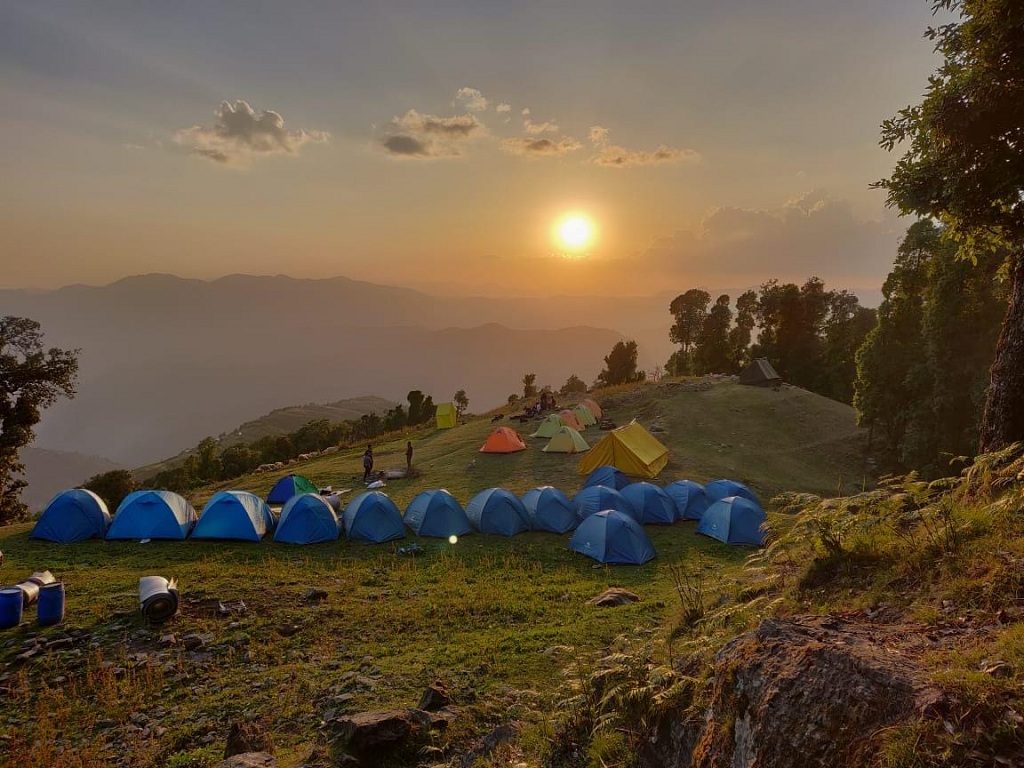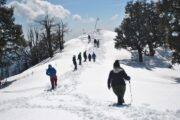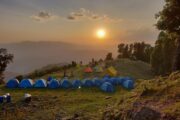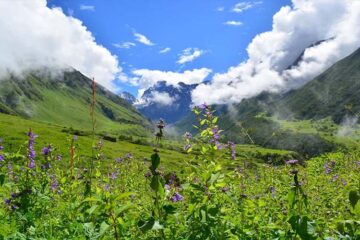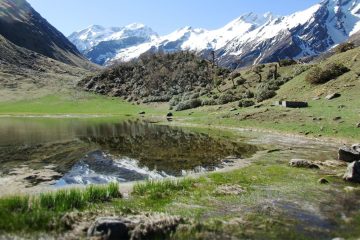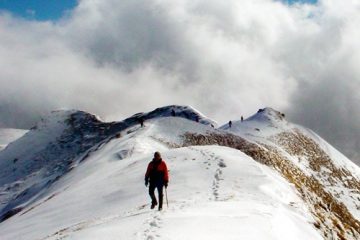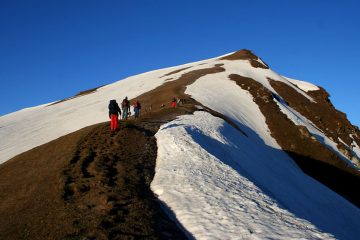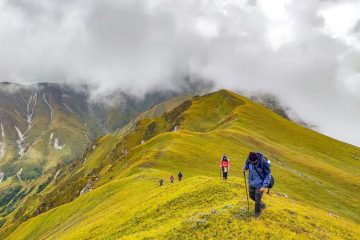The Nag Tibba Trek
Region :- Uttarakhand
Snow: December to March
With a height of over 9,900 feet, is the very best height within the lesser mountains of the Garhwal Himalayas. Rife with richly colored forests and flora, the trek to Nag Tibba is best for travellers searching for a quick journey inside the Himalayas.
You’ll see heavenly landscapes painted white with sparkling snow in the winter, freshly inexperienced flora and leaves in inexperienced meadows in the monsoon, and open terrain with sweeping perspectives in the summer on this all-season trek. The trek to Nag Tibba takes you over a step-by-step inclining route, making it best for travellers with little to no hiking experience.
Nag Tibba (‘Serpent’s Peak’), 3,022 metres (9,915 ft), is the highest peak in the lesser Himalayan region of Uttarakhand state (Garhwal Division) and a region of Bugyals (High Altitude Meadows) .It lends its name to the ‘Nag Tibba Range’, itself the next-northerly of the five folds of the Himalaya. It is situated 16 km (9.9 mi) away from Landour cantonment, and around 57 km from Mussoorie and 148km from New Tehri in Tehri Garhwal district of Uttarakhand. The ‘Nag Tibba Range’ is amongst three principal ranges of the Lesser Himalayas, which includes the Dhauladhar, and the Pir Panjal, which branched off from the Great Himalayas.
Day 1- Drive from Dehradun to Pantwari and trek to Kathian Campsite
We will start the excursion with an early morning drive to Pantwari via Mussorie and Kempty falls. Witness terraced farms and hill slopes with lovely Bauhinia trees. We will attain Pantwari after 3.5 hours of power and an ascent to the campsite.
Day 2- Trek to Nag Tibba top and return to Pantwari; Drive to Dehradun
Today we are able to trek to the Nag Devta temple, publish our breakfast there, and pay our obeisance there.
Day 1- Drive from Dehradun to Pantwari and trek to Kathian Campsite
We will start the excursion with an early morning drive to Pantwari via Mussorie and Kempty falls. Witness terraced farms and hill slopes with lovely Bauhinia trees. We will attain Pantwari after 3.5 hours of power and an ascent to the campsite.
Throughout the campsite, you will see a wide variety of plant life and birds, including Blue-cheeked bulbul, hill myna, jungle babbler, and Red-vented bulbul. We will start the trek from the primary street of Pantwari and climb up the ridge face. Leaving the village behind, we can go to Goat Village down the steep path and enter a dense rhododendron forest.
Day 2- Trek to Nag Tibba top and return to Pantwari; Drive to Dehradun
Today we are able to trek to the Nag Devta temple, publish our breakfast there, and pay our obeisance there. After journeying the temple, we are able to stroll similarly for one hour extra to Nag Tibba pinnacle thru dense forests of rhododendrons and oaks.
Witness quite a few birds, inclusive of Niltava and Flameback woodpeckers, on the way. Visit the Nag Tibba pinnacle and descend to Pantawari village for lunch. Drive to Dehradun, marking the end of this excellent tour.
By Air:-
Dehradun’s Jolly Grant Airport is located about 20 km from the city. You will find a daily flight from Delhi to Dehradun.
Taking the train:
Take the overnight train to Dehradun from Delhi.
- Nandadevi Express-Departure at 11:50pm; Arrival at 5:40am
- Dehradun Express-Departure-9:10pm; Arrival-5:00am
By Bus:-
From Delhi’s ISBT Kashmere Gate, a regular bus service from Delhi to Dehradun is available.
Includes
- Meals during the trek
- Forest Permits/Camping Charges (only if availing transportation through A1 Himalayas). Only up to the amount charged for Indian Nationals is included.
- Tents, sleeping bags, mats
- Safety equipment includes static rescue rope, seat harness, carabiners, pulleys,
- Trek guide, cook, helpers, porters, & mules for carrying common luggage.
- The Services of a Certified Trek Leader
Excludes
- Meals during road journeys
- Transportation from Dehradun to Pantwari and back to Dehradun.
- Carriage of personal bags during the trek
- Any kind of insurance
- Any expense of a personal nature.
- Any expense not specified in the inclusion list
1) Trekking Shoe/Snow Shoe
2) Rucksack/Back Pack
3) Rucksack cover (Waterproof)
4) Daypack/Knapsack
5) Undergarments/Innerwear
6)Woolen socks
7) Woolen gloves
8) Waterproof gloves
9) T-shirt
10) Trek pants
11) Camp sandal
12) Balaclava/Woolen skull
cap/Monkey Cap
13) Sun cap/Wide-brimmed
Hat/Bandana
14) Walking Sticks/Trekking
Poles/Ski Poles
15) Heavy Jacket
16) Windproof Jacket/Wind
Cheater
17)Raingear/Poncho/Waterproof clothing
18) Water bottle/Hydration pack
19) Sunscreen lotion
20) Sunglasses
21) ChapStick/Cold &
Moisturizing cream
22) Toothbrush and toothpaste
23) Towel
24) Hand sanitizer
25) Tissue roll ( Toilet)
26) Anti Fungal Powder
27) Torch/Head Lamp with extra batteries
28) Knee cap
29) Camera with extra cells
30) Dry food items
31) Personal first-aid kit
32) Medicines (This is a simple
guide line and a doctor’s
consultation is recommended.)
Altitude is a risk. Before you begin the trek, you should be aware of the effects of high altitude on your body. Acute Mountain Sickness (AMS) symptoms include a moderate headache, nausea, and overall discomfort.
Reponse: If you have any of these symptoms, notify the trek leader immediately and follow his advice. To deal with the scenario, each campsite contains a stretcher, a fully prepared first aid kit, and oxygen cylinders.
Weather Risk : No one can guarantee snow, rain, or sunlight, even if we keep a constant eye on the weather. Please keep in mind that your safety is our primary priority, and if the weather isn’t cooperating, we won’t leave the campsite.
Response: The choice to go or wait for better weather will be made solely by the Trek Leaders and Guides.
Risk: Injury is a possibility. While trekking across difficult terrains, minor injuries such as calf sprains, bruising, and other minor ailments are prevalent. Serious injuries, such as fractures or significant cuts, are quite uncommon.
Response: All of our Trek Leaders are trained in wilderness first aid. They’ve been taught to deal with emergencies and have a well-stocked first-aid equipment to deal with minor injuries. In the event of major injuries, the patient is carried to the nearest road-head on a stretcher and taken to the nearest medical facility.
DO’S AND DON’TS ON A TREK
1. Alcohols or any other intoxicating products ‘’STRICTLY PROHIBHITED’’
during the trek.
2. Always pay heed to the trek guides or instructors.
3. Try not to leave the group under any circumstances.
4. Avoid trekking during the nights as it is extremely dangerous.
5. Avoid using earphones as that might hinder your hearing.
6. Do not participate or encourage littering of the places in any form.
7. While visiting the local villages and tourist sites, obey the local guidelines
and instructions.
8. Do not harm or interrupt the local sentiments of the places.
IMPORTANT:
Your safety is of paramount concern while traveling with A1 Himalayas.
Please note that your leader has the authority to amend or cancel any part of
the itinerary if it is deemed necessary due to safety concerns. Since adventure
entails traveling in remote mountainous regions, we cannot guarantee that we
will not deviate from it. Weather conditions, health condition of a group
member, unexpected natural disasters, etc., can all contribute to changes in
the itinerary. The leader will try to ensure that the trip runs according to plan,
but please be prepared to be flexible if required.

